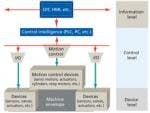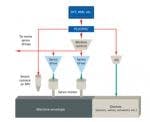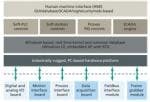Practical Device Networks
By Loren Shaum, contributing editor
Legacy machines have many more hard-wired devices than networked devices. That’s no surprise. But today, with manufacturers demanding smaller, cheaper machines with quicker delivery and commissioning, machine builders must focus on ways to reduce build and start-up times. Less wiring is an important means to accomplish those objectives.
In a typical machine, there can be multiple levels of networking depending on machine complexity. Figure 1 represents a typical machine, showing elements invariably found on every machine in one form or another.
The Basic Element
Figure 1: A typical machine connectivity diagram. Green
arrows represent typically hardwired elements, while red arrows represent typically networked devices.
The challenge for machine builders is to figure out which elements can be networked. If the machine is spread over a large factory-floor envelope, then networking from a central or distributed control intelligence source makes sense. Distributing networkable I/O and servo drives strategically throughout a machine envelope based on functionality looks like a great design idea. The higher the device count and the larger the machine, the more reason to choose distributed, network-connected control.
What really determines a network choice? Perhaps it comes down to something as basic as serial connectivity versus parallel connectivity, i.e., connecting everything in some kind of “daisy-chain” arrangement, rather than connecting each device directly to the control intelligence. Figure 1 indicates the levels of connectivity typically required on every machine.
Simplifying Network Designs
The really time-consuming parts of any machine commissioning are wiring and programming, and their subsequent debugging. Consequently, keeping hardware platforms less complex becomes a driving force toward simplicity. Multiple hardware configurations (Figure 2) are tougher to implement and debug in a timely fashion, and still remain competitive.
With an integrated PC-based control solution (Figure 3), control and network complexity is reduced, especially when more common fieldbus drivers are onboard. With such controller configurations, machine builders and system integrators can standardize controls across multiple machine configurations, and implement local or distributed motion and/or I/O control on one compatible network.
One machine builder incorporating this strategy is DynaPath, Livonia, Mich. DynaPath has been supplying machine tools and retrofit controls since 1957. “In this competitive market, we need a control strategy that’s the simplest to integrate into any of our machines, simplest to debug, and provides all the control functions that our machines require,” stresses Paul Barnhardt, DynaPath’s sales VP. “We can interface easily to servos and devices with the controls mounted on the machine.”
Dynapath uses HA Controls’ software-based, networkable machine control built around HA’s Performance Series (P Series) machine controllers. P Series is a compact hardware platform with several touchscreen sizes and software for HMI, SCADA, PLC and motion control—plus multiple fieldbus drivers—integrated on one WinPC32 Pro platform. “Our platform offers more functions with less hardware, and for networking we can incorporate drivers for virtually any fieldbus,” claims Dr. Jacob Pien, president, HA Controls. “This allows machine builders to connect seamlessly to their fieldbus for instant networking.”
Device-Level Networking
Devices on machines sometimes incorporate intelligence for functionality and/or network connectivity. As device intelligence increases, networkability increases, too. Several suppliers now offer fully networkable smart devices. Even with the move to smarter devices, most installed device connectivity remains hardwired, some to a network interface module, while others are wired directly to the control intelligence through I/O interfacing. If wired to a network interface, connections can be made to a number of proprietary networks.
Complex Connectivity
Figure 2: A classic, complex machine architecture with intelligent sensors, motion control, HMI, and communication drivers can have significant debugging requirements. Red arrows represent possible networked devices, while green arrows represent largely hardwired devices.
“I have no hard numbers, but I’d be very surprised if the ratio of installed intelligent sensors to standard sensors is more than 0.1%,” says Helge Hornis, manager of Intelligent Systems Group at Pepperl+Fuchs. “I know of AS-Interface and DeviceNet sensors, but I’m not aware of any Profibus or Ethernet sensors. The situation is different if you include safety inputs. Lots of AS-Interface-compatible e-stops and door interlocks are deployed. That ratio might be as high as 10%, and is increasing as companies improve their solutions.” These numbers seem small given all the hype about smart wireless devices.
Brian Oulton, marketing manager for networks at Rockwell Automation supports Hornis’ views, particularly as they apply to Rockwell’s supported networks. “Very few sensors are directly on a network,” he says. “Machine builders don’t want to deal with multiple networks, particularly on smaller machines. Regardless, most machines now use two networks, DeviceNet at the device and in non-real-time control levels, and EtherNet/IP for real-time control and information gathering. For point I/O installations, it’s about 50-50 between DeviceNet and EtherNet/IP, but we are also seeing a lot of serial device connections.”
In reality, simple devices such as basic sensors and switches likely never will be networkable. Currently P+F promotes AS-i as the means to get device signals to the control level, which often requires bridging to another network.
Control Level Networking
Depending on how mission-critical their device information might be, many machine builders bypass secondary networks and hardwire directly to I/O on higher-speed networks in the control layer. For high-speed machines, real-time networks are essential. In Fall 2006, Industrial Networking examined the Open System Interconnect (OSI), seven-layer model, and how it applies to non-real-time applications because migrating through the entire seven-layer model just takes too much time [“OSI 7-Layer Model Tough to Follow,”]. All networks claiming determinism bypass some portion of that model, which in turn, makes those networks proprietary.
Integrated Controls
Figure 3: With an integrated PC-based solution, control and network complexity are reduced, especially when common fieldbus drivers are used.
in Sandpoint, Idaho, manufactures roasting machines that control a combination of heat, airflow, and timing to create an optimum roasting environment for coffee beans. “Optimal roasting requires precise process control,” says Dave Williams, Diedrich’s software engineer. “Our machines provide very fine control over the coffee roast, and by adding automation, our users can maintain that one variation point or roast profile they strive for.”Diedrich Manufacturing
Diedrich’s control solution includes a CompactLogix controller running RSLogix software and a PanelView touchscreen operator interface monitoring and controlling five or more variable-frequency drives, depending on the size of the system. The control system is connected by EtherNet/IP, allowing remote technical support and roaster diagnostics via a virtual private network (VPN). “What used to take us three weeks to configure now takes about three hours,” Williams says.
The trend is toward vertical integrating intelligent sensors and actuators into machine controls, as well as the controls into a plant network, says B&R Industrial Automation engineering manager Robert Muehlfellner. “The advantage of networking, besides the primary I/O information, is that a lot of additional status, diagnostics, and setup information can be obtained from a networked device,” he states. “This information is within the machine controller, but through vertical integration also can be brought into a supervisory, plant-level, data-collection system. It also can allow for more thorough local and remote diagnostic information through the Internet.” B&R’s answer is Ethernet PowerLink, but there are few devices that connect directly to PowerLink except certain intelligent drives. So B&R offers I/O and control connectivity for many of the popular device networks.
Wireless, of Course
And then there is the case for wireless device networking. GE, Emerson, Honeywell, and other large process automation suppliers flaunt wireless as the future for device networking. With these big guys on the bandwagon, the credibility of wireless technology takes on a new, if sometimes squabbling, mantra. But it also opens the door to innovative technology companies to participate in this emerging market. Currently there are approximately 25 suppliers offering some sort of wireless networking solution.
Sensible Wireless
Figure 4: Some wireless device networking solutions offer smart, battery-operated devices for measuring and monitoring process variables and other essential data. With mesh routers, device information is relayed to a gateway that interfaces to machine or process control software.
Thoughts of deploying a wireless system on a machine or process might be daunting to most, but there are, nonetheless, a number of ongoing applications. One installation where a wireless strategy comes together is at Logan Aluminum, Russellville, Ky. Logan manufactures aluminum sheet products. To improve efficiency and safe handling of 300 °C aluminum coils, the coil temperature must be monitored before handling and transfer to a cold mill for further processing. Warner Williams, Logan’s electrical engineer, uses wireless temperature sensors, routers and a bridge to interface with the existing plant network. Once the data is processed through the Logan network and mainframe, the information is transferred directly to crane operators.
The system deployment took two months because of software required to communicate with the installed network. “When I heard about the SensiCast system and researched the website, it appeared to be the right solution because the whole system is from one source.,” says Williams. “We needed to put in a system that works when the power is turned on, and that is about what this was.”
SensiCast Systems’, SensiNet, end-to-end wireless device networking solutions offer a number of smart, battery-operated devices for measuring and monitoring variables such as power, temperature, humidity, pressure, flow and other essential machine and process data. Via SensiNet mesh routers, device information is relayed to a gateway that interfaces to machine or process control software (Figure 4).
For the moment, however, the consensus is that wireless device networking is not viable for mission-critical applications. Security issues and fool-proof signal transmission still have a ways to go.
The Secondary Network Connection
Non-real-time networks often are referred to as secondary networks. A list of device level networks would include:
- DeviceNet: Rockwell Automation origins, supported through ODVA (www.ovda.org/). A fieldbus with a defined protocol, it can be used at the control level, but it is relatively slow compared to other fieldbus networks and even some secondary networks.
- ControlNet: Also has Rockwell origins and supported by OVDA. ControlNet is faster than DeviceNet.
- AS-i: Actuator Sensor-Interface is supported by As-i Intl. (www.as-interface.org/). AS-i claims 12 million nodes installed, mostly in Europe. A two-wire configuration, it is always on, transmission speed like HART
- HART: Highway Addressable Remote Transducer (www.hartcomm2.org/) uses two-wire digital transmissions, while simultaneously transmitting 4-20ma process signals and is used almost entirely in process control applications.
- Modbus: With Schneider Electric origins, Modbus (www.modbus.org/) has three versions. The serial version was created initially by Modicon to interface compatible devices to PLCs. Modbus is the most commonly used network in SCADA applications.
- Interbus: A Phoenix Contact development, Interbus (www.interbusclub.com/ initially focused on automobile applications. It is one of the least-used networks in the U.S.
- LonWorks Pyxos: A new device network chip from Echelon (www.echelon.com/) is being touted by some as applicable for device networking on machines.
None of these networks are used for transmitting real-time information in mission-critical applications.





